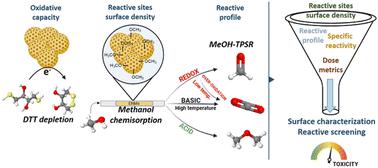当前位置:
X-MOL 学术
›
Environ. Sci.: Nano
›
论文详情
Our official English website, www.x-mol.net, welcomes your
feedback! (Note: you will need to create a separate account there.)
In chemico methodology for engineered nanomaterial categorization according to number, nature and oxidative potential of reactive surface sites
Environmental Science: Nano ( IF 5.8 ) Pub Date : 2024-07-09 , DOI: 10.1039/d3en00810j V Alcolea-Rodriguez 1 , R Portela 1 , V Calvino-Casilda 2 , M A Bañares 1
Environmental Science: Nano ( IF 5.8 ) Pub Date : 2024-07-09 , DOI: 10.1039/d3en00810j V Alcolea-Rodriguez 1 , R Portela 1 , V Calvino-Casilda 2 , M A Bañares 1
Affiliation

|
Methanol probe chemisorption quantifies the number of reactive sites at the surface of engineered nanomaterials, enabling normalization per reactive site in reactivity and toxicity tests, rather than per mass or physical surface area. Subsequent temperature-programmed surface reaction (TPSR) of chemisorbed methanol identifies the reactive nature of surface sites (acidic, basic, redox or combination thereof) and their reactivity. Complementary to the methanol assay, a dithiothreitol (DTT) probe oxidation reaction is used to evaluate the oxidation capacity. These acellular approaches to quantify the number, nature, and reactivity of surface sites constitute a new approach methodology (NAM) for site-specific classification of nanomaterials. As a proof of concept, CuO, CeO2, ZnO, Fe3O4, CuFe2O4, Co3O4 and two TiO2 nanomaterials were probed. A harmonized reactive descriptor for ENMs was obtained: the DTT oxidation rate per reactive surface site, or oxidative turnover frequency (OxTOF). CuO and CuFe2O4 ENMs exhibit the largest reactive site surface density and possess the highest oxidizing ability in the series, as estimated by the DTT probe reaction, followed by CeO2 NM-211 and then titania nanomaterials (DT-51 and NM-101) and Fe3O4. DTT depletion for ZnO NM-110 was associated with dissolved zinc ions rather than the ZnO particles; however, the basic characteristics of the ZnO NM-110 particles were evidenced by methanol TPSR. These acellular assays allow ranking the eight nanomaterials into three categories with statistically different oxidative potentials: CuO, CuFe2O4 and Co3O4 are the most reactive; ceria exhibits a moderate reactivity; and iron oxide and the titanias possess a low oxidative potential.
中文翻译:

在化学方法中,根据反应表面位点的数量、性质和氧化电位对工程纳米材料进行分类
甲醇探针化学吸附可量化工程纳米材料表面的反应位点数量,从而能够在反应性和毒性测试中对每个反应位点进行标准化,而不是按质量或物理表面积进行标准化。随后化学吸附甲醇的程序升温表面反应 (TPSR) 确定了表面位点的反应性质(酸性、碱性、氧化还原或其组合)及其反应性。作为甲醇测定的补充,二硫苏糖醇 (DTT) 探针氧化反应用于评估氧化能力。这些量化表面位点的数量、性质和反应性的非细胞方法构成了纳米材料位点特异性分类的新方法(NAM)。作为概念验证,研究了 CuO、CeO 2 、ZnO、Fe 3 O 4 、CuFe 2 O 4 、Co 3 O 4和两种 TiO 2纳米材料。获得了 ENM 的统一反应描述符:每个反应表面位点的 DTT 氧化速率,或氧化周转频率 (OxTOF)。根据 DTT 探针反应估计,CuO 和 CuFe 2 O 4 ENM 在该系列中表现出最大的反应位点表面密度,并具有最高的氧化能力,其次是 CeO 2 NM-211,然后是二氧化钛纳米材料(DT-51 和 NM- 101)和Fe 3 O 4 。 ZnO NM-110 的 DTT 消耗与溶解的锌离子有关,而不是与 ZnO 颗粒有关;然而,ZnO NM-110 颗粒的基本特征通过甲醇 TPSR 得到了证实。这些无细胞测定可以将八种纳米材料分为三类,具有统计上不同的氧化电位:CuO、CuFe 2 O 4和 Co 3 O 4反应性最强;二氧化铈表现出中等反应活性;氧化铁和二氧化钛具有低氧化电位。
更新日期:2024-07-09
中文翻译:

在化学方法中,根据反应表面位点的数量、性质和氧化电位对工程纳米材料进行分类
甲醇探针化学吸附可量化工程纳米材料表面的反应位点数量,从而能够在反应性和毒性测试中对每个反应位点进行标准化,而不是按质量或物理表面积进行标准化。随后化学吸附甲醇的程序升温表面反应 (TPSR) 确定了表面位点的反应性质(酸性、碱性、氧化还原或其组合)及其反应性。作为甲醇测定的补充,二硫苏糖醇 (DTT) 探针氧化反应用于评估氧化能力。这些量化表面位点的数量、性质和反应性的非细胞方法构成了纳米材料位点特异性分类的新方法(NAM)。作为概念验证,研究了 CuO、CeO 2 、ZnO、Fe 3 O 4 、CuFe 2 O 4 、Co 3 O 4和两种 TiO 2纳米材料。获得了 ENM 的统一反应描述符:每个反应表面位点的 DTT 氧化速率,或氧化周转频率 (OxTOF)。根据 DTT 探针反应估计,CuO 和 CuFe 2 O 4 ENM 在该系列中表现出最大的反应位点表面密度,并具有最高的氧化能力,其次是 CeO 2 NM-211,然后是二氧化钛纳米材料(DT-51 和 NM- 101)和Fe 3 O 4 。 ZnO NM-110 的 DTT 消耗与溶解的锌离子有关,而不是与 ZnO 颗粒有关;然而,ZnO NM-110 颗粒的基本特征通过甲醇 TPSR 得到了证实。这些无细胞测定可以将八种纳米材料分为三类,具有统计上不同的氧化电位:CuO、CuFe 2 O 4和 Co 3 O 4反应性最强;二氧化铈表现出中等反应活性;氧化铁和二氧化钛具有低氧化电位。











































 京公网安备 11010802027423号
京公网安备 11010802027423号